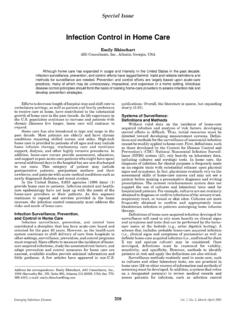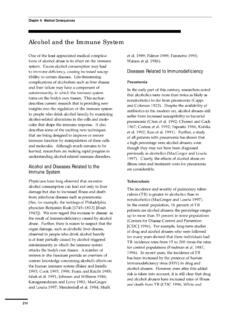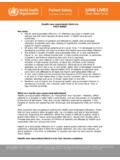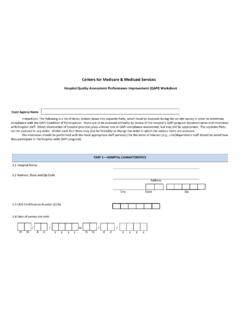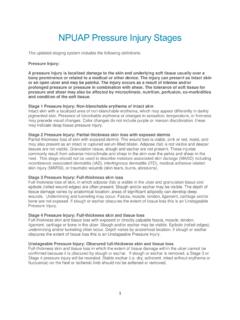Transcription of What Clinicians Need to Know about Legionnaires’ Disease
1 What Clinicians Need to Know about LEGIONNAIRES DISEASEL egionnaires Disease is a sometimes fatal form of pneumonia that is on the rise in the United States. Unfortunately, this Disease is also underrecognized and underdiagnosed. Clinicians are in a unique position to make sure cases are detected, allowing rapid investigation by public health officials and prevention of additional and TestingClinical features of Legionnaires Disease include cough, fever, and radiographic pneumonia. Signs and symptoms for Legionnaires Disease are similar to pneumonia caused by other pathogens; the only way to tell if a pneumonia patient has Legionnaires Disease is by getting a specific diagnostic test.
2 Indications that warrant testing include: Patients who have failed outpatient antibiotic therapy for community-acquiredpneumonia Patients with severe pneumonia, in particular those requiring intensive care Immunocompromised patients with pneumonia* Patients with a travel history (patients who have traveled away from their homewithin 10 days before the onset of illness) All patients with pneumonia in the setting of a Legionnaires Disease outbreak Patients at risk for Legionnaires Disease with healthcare-associated pneumonia(pneumonia with onset 48 hours after admission)
3 * Clinicians may also consider testing for Legionnaires Disease in patients with other risk factors for this infection (see page 2).Testing for healthcare-associated Legionnaires Disease is especially important if any of the following are identified in your facility: Other patients with healthcare-associated Legionnaires Disease diagnosedin the past 12 months Positive environmental tests for Legionella in the past 2 months Current changes in water quality that may lead to Legionella growth (such as lowchlorine levels)Infection control staff may have more information about these situations in your preferred diagnostic tests for Legionnaires Disease are culture of lower respiratory secretions ( , sputum, bronchoalveolar lavage) on selective media and the Legionella urinary antigen test.
4 Serological assays can be nonspecific and are not recommended in most situations. Best practice is to obtain both sputum culture and a urinary antigen test concurrently. Sputum should ideally be obtained prior to antibiotic administration, but antibiotic treatment should not be delayed to facilitate this process. The urinary antigen test can detect Legionella infections in some cases for days to weeks after treatment. The urinary antigen test detects Legionella pneumophila serogroup 1, the most common cause of Legionnaires Disease ; isolation of Legionella by culture is important for detection of other species and serogroups and for public health investigation.
5 Molecular techniques can be used to compare clinical isolates to environmental isolates and confirm the outbreak both a culture of a lower respiratory specimen and a urinary antigen test when testing patients for the United States, reported cases of Legionnaires Disease have grown by nearly nine times since 2000. Nearly 10,000 cases of Legionnaires Disease were reported in 2018, but this number is likely an underestimate as the illness is thought to be illness occurs in the summer and early fall, but Legionnaires Disease can happen any time of (cases/100,000 pop.)
6 YearLegionnaires Disease Is On the Rise2000 2018**National Notifiable Disease Surveillance SystemTreatmentIf your patient has Legionnaires Disease , see the most recent guidelines for treatment of community- acquired pneumonia ( ) and hospital- acquired pneumonia ( ). Macrolides and respiratory fluoroquinolones are currently the preferred agents for treating Legionnaires Disease . ReportingMake sure your infection control department or lab are promptly reporting cases of Legionnaires Disease to your local health department. Timely identification and reporting of cases is important, as this allows public health officials to quickly identify and stop potential clusters and outbreaks by linking new cases to previously reported ones.
7 EtiologyLegionnaires Disease is a severe form of pneumonia that often requires hospitalization and is fatal in about 10% of cases overall, and in 25% of healthcare-associated cases. Legionnaires Disease is caused by Legionella bacteria. There are at least 60 different species of Legionella, and most are considered capable of causing Disease . However, most Disease is caused by L. pneumophila, particularly serogroup Legionella is found in natural, freshwater environments, it can become a health concern in human-made water systems ( , plumbing system of large buildings, cooling towers, certain medical devices, decorative fountains, hot tubs) where conditions allow it to multiply and come in contact with vulnerable persons.
8 People contract Legionella by inhaling aerosolized water droplets containing the bacteria, or, less commonly, by aspiration of contaminated drinking water. Legionella is usually not transmitted from person to person; however, a single episode of person-to-person transmission has been reported. Fortunately, most people exposed to the bacteria do not become FactorsRisk factors for developing Legionnaires Disease include: Age 50 years Smoking (current or historical) Chronic lung Disease , such as emphysema or COPD Immune system disorders due to Disease or medication Systemic malignancy Underlying illness, such as diabetes, renal failure, or hepatic failurePreventionThe key to preventing Legionnaires Disease is maintenance of the water systems in which Legionella may grow.
9 If Legionella is found in a healthcare facility s water system, the facility should work to eliminate the bacteria. CDC encourages all building owners, and especially those in healthcare facilities, to develop comprehensive water management programs to reduce the risk of Legionella growth and spread. Learn more about how to develop a water management program at Timely reporting of Legionnaires Disease cases is important for controlling clusters and Sources of InfectionOutbreaks of Legionnaires Disease are most often associated with large or complex water systems, like those found in hospitals, long-term care facilities, hotels, and cruise most likely sources of infection include:Water used for showering (potable water)Cooling towers (parts of large air conditioning systems)Decorative fountainsHot | CS315179-A 02/24/2020












